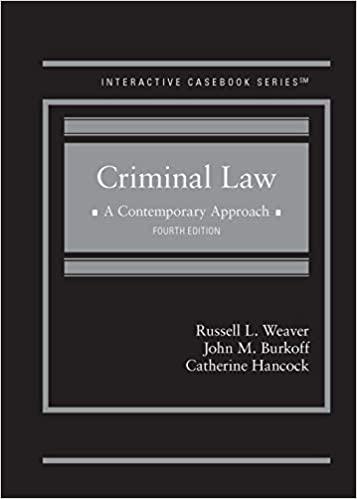Question
Cooper et al. Vs. Coverdale Fabrication Co. (CFC) John Cooper and Beth Mason were part of CFC's Employee Stock Ownership Plan (ESOP). The company is
Cooper et al. Vs. Coverdale Fabrication Co. (CFC)
John Cooper and Beth Mason were part of CFC's Employee Stock Ownership Plan (ESOP). The company is based in Illinois. One hundred percent of CFC's stock is owned by the ESOP with each employee owning a percentage of shares based upon length of employment and compensation. When Lionel Hunt, former owner of CFC announced his retirement John Cooper, a 24 year employee was elected by the board of directors as chairman of the board and within a few months he also became the Chief Executive Officer of CFC.
Beth Mason was an 18 year employee who worked her way up to Vice President of Finance. Following Hunt's retirement, Mason was approved by the board to be a candidate for employees to vote her in as a co trustee with Cooper of the ESOP and later was named President of CFC and remained on the board of directors.
After a year of retirement Hunt had an argument with Cooper and Mason over keeping an employee that worked for both CFC and Hunt's other business. Hunt informed Cooper in writing as the CEO that he was not happy with the way things were being handled.
One month later both Cooper and Mason were terminated by CFC based upon Hunt's vote of 189 employee's proxies and powers of attorney. Also, both were removed as trustees of the ESOP and John Hunt was voted in as the CEO and sole trustee of the ESOP. According to the records Cooper and Mason were terminated based upon the majority of the employees having signed POA's or other proxies to John Hunt requesting that Cooper and Mason be fired.
As former employees of CFC Cooper and Mason maintained their interest in the ESOP. Cooper was the largest single owner of shares. They sent a letter requesting inspection of the corporate records including the proxies and POA's used to terminate them and a list of shareholders at that time. They did receive copies of minutes but the proxies,POA's, and list of shareholders were withheld. Cooper and Mason filed suit.
CFC told the court that the denial of certain records was because Cooper and Mason did not have standing. That the shares were held by the ESOP and that they were not "shareholders" as defined by the business corporations code. 100% of the shares were registered in the name of the ESOP though each employee's interest is enumerated in "shares". Letters received by Cooper and Mason from the attorneys representing CFC also referred to them as shareholders.
So, how do you think the court should find? Do Cooper and Mason have the right to inspect not just minutes but all the records? What does the law say about this? Use citation please.
Step by Step Solution
There are 3 Steps involved in it
Step: 1

Get Instant Access to Expert-Tailored Solutions
See step-by-step solutions with expert insights and AI powered tools for academic success
Step: 2

Step: 3

Ace Your Homework with AI
Get the answers you need in no time with our AI-driven, step-by-step assistance
Get Started


